Under the surface of titles, trophies, and televised glory, there runs a deeper current that truly defines power in football – money. And more specifically, the capacity to spend it. For all the tactical revolutions and golden generations that have coloured the sport over the past century, it is financial might – and how it is wielded in the transfer market – that ultimately tells the story of who controls the global game. Sportingpedia’s latest report charts that financial power through time, following five distinct historical phases that reveal the shifting tectonic plates beneath world football. It is a forensic investigation into which clubs, leagues, and countries have ruled the market – and how the crown has passed hands over the last 75 years. One of the report’s most curious revelations is that England’s share among the top 20 spending clubs has more than doubled since 2000–2010, while both Italy and Spain have seen a steady decline in financial power over the same period.
Spending by country based on Top 20 highest-spending clubs by era (1950-Now)
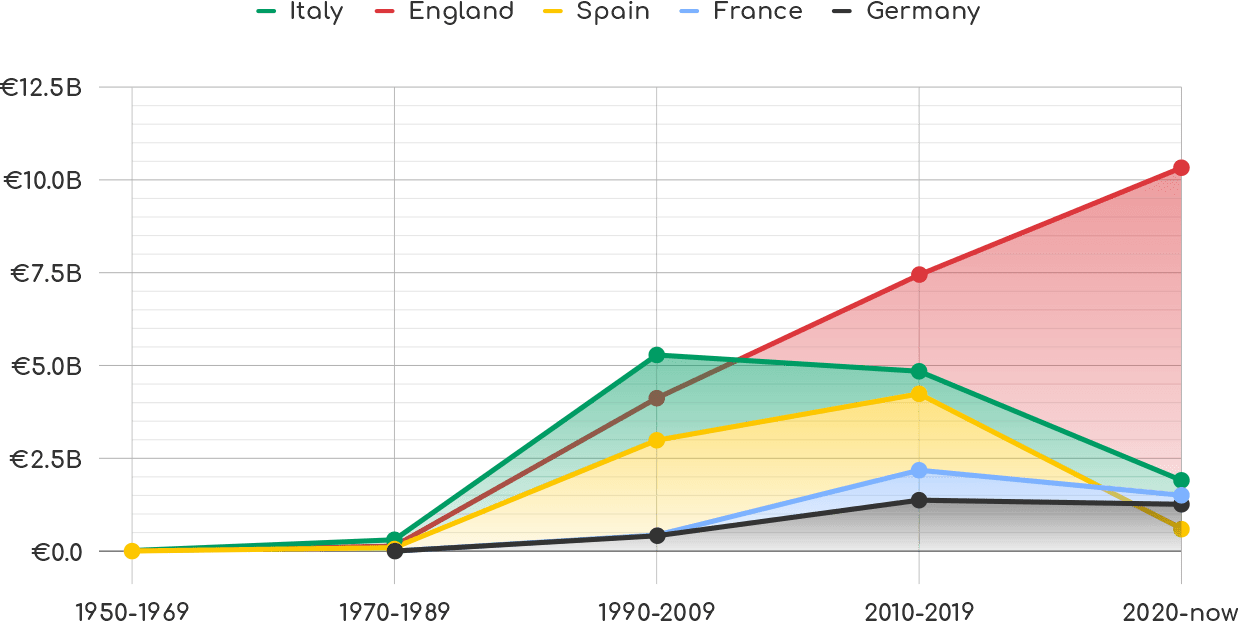

Data Source: Transfermarkt
We begin in the 1950s, not because football was born then, but because the age of continental competition had just begun. The foundation of the European Cup in 1955 changed everything. It offered the first real opportunity for clubs to compete not just for domestic dominance, but for international supremacy. This demanded stronger squads, deeper investments, and broader ambitions – fuelling the earliest signs of a cross-border transfer market.
The 20 Football clubs in the world that spent the most money on transfers (1950/51-1969/70)
Breakdown by Country
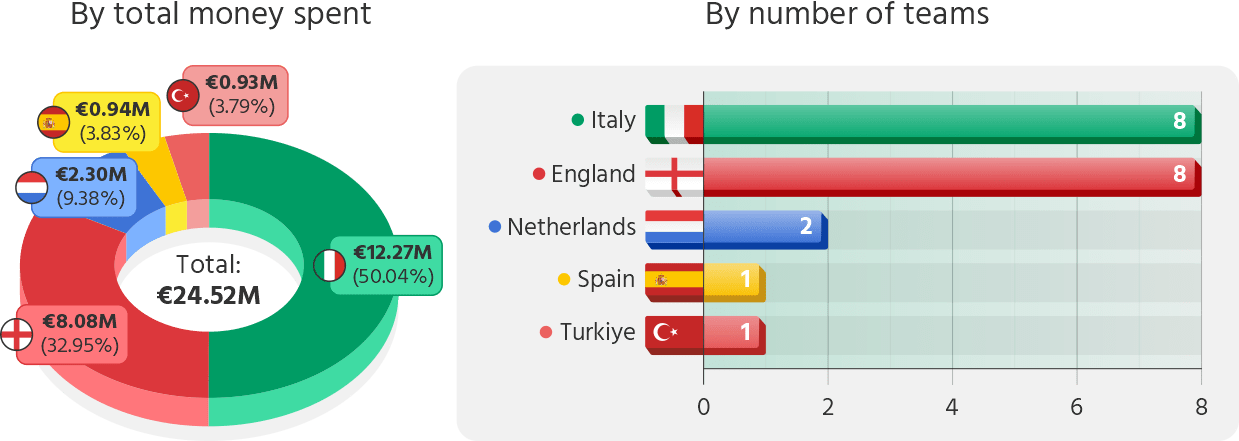

Data Source: Transfermarkt
Between 1950 and 1970, Italy reigned as the game’s economic powerhouse. In raw expenditure terms, no one came close. Italian clubs made up 50 percent of the €24.56 million total spent by the top 20 highest-spending sides of the era. Juventus alone outspent every other club by a margin of nearly three to one, laying down €6.25 million, while Inter, Roma, Milan, and Bologna added muscle to Serie A’s financial superiority. England also fielded eight clubs among the top 20, including Everton, Tottenham, and Liverpool, but their total spend of €8.08 million – accounting for around 33 percent of the total – couldn’t match Italy’s €12.27 million. The Netherlands, with Feyenoord and Ajax, contributed a further 9 percent, while Spain and Turkiye had lone representatives in Barcelona and Fenerbahce. What made this early phase so notable was not just the raw figures, modest by today’s standards, but the proportions. This was an Italian-dominated market at a time when television rights were localised, sponsorships were limited, and football was still an essentially European affair. Yet the spending patterns already hinted at a future where global economic influence would reshape club hierarchies.
The 20 Football clubs in the world that spent the most money on transfers (1970/71–1989/90)
Breakdown by Country
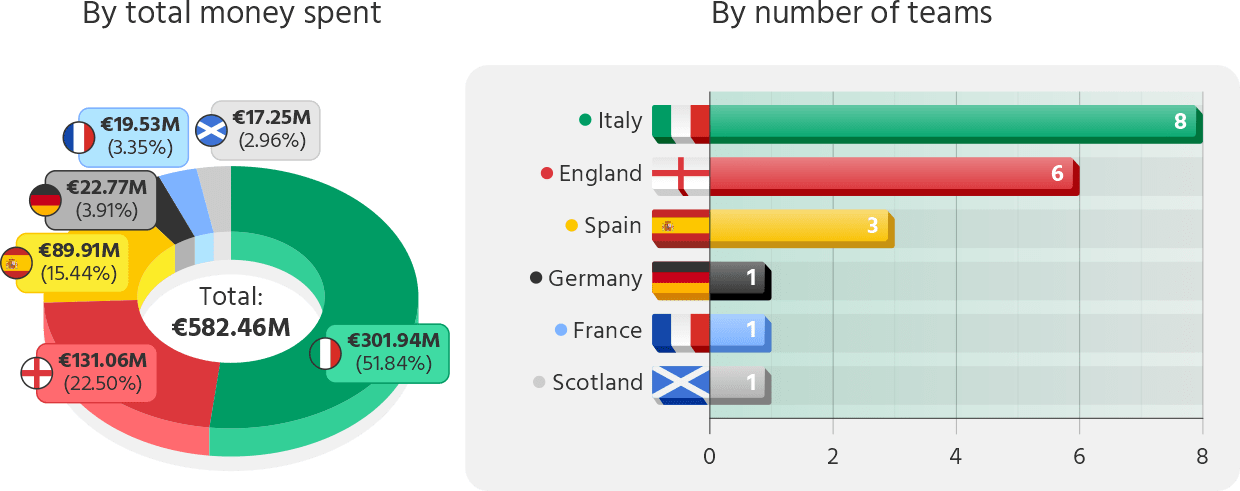

Data Source: Transfermarkt
From 1970 to 1990, Italy didn’t just maintain their lead – they expanded it beyond recognition. With eight clubs again in the top 20, Serie A’s total exploded to €301.94 million, accounting for just over 50 percent of the total once again. Juventus, Inter, Milan, and Napoli now led the charge, each spending over €45 million in that period. Spain emerged as a rising force through Barcelona, Real Madrid, and Atletico, reaching nearly €90 million, while England held its position with six clubs and a total of €131 million. Germany, France, and Scotland entered the fray with Bayern, Marseille, and Rangers respectively, though they remained peripheral actors. Even more striking was the consistency of Italian presence: eight teams in both of the first two periods, reinforcing not just dominance in total expenditure, but sustained breadth of high-spending representation. Crucially, the Italian league’s market share remained stable in percentage terms, but the actual figures had grown 25 times in just 20 years – from €12 million to over €300 million. This was the beginning of the era where television and commercial revenue began trickling into club operations, and Italy capitalised first.
The 20 Football clubs in the world that spent the most money on transfers (1990/91–2009/10)
Breakdown by Country
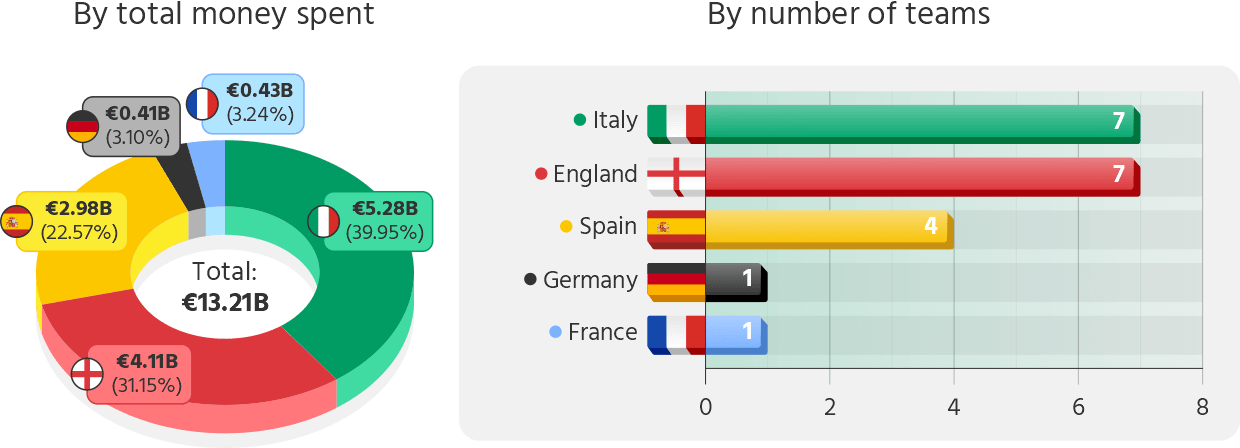

Data Source: Transfermarkt
The post-1990 era marked a turning point. Football underwent a commercial metamorphosis. The Bosman ruling redefined player mobility, Champions League revenues surged, and a global fanbase started injecting fresh capital into the elite. Between 1990 and 2010, the total expenditure of the top 20 clubs ballooned to over €13 billion. Italy still led with €5.28 billion – largely due to Inter, Juventus, Milan, and the aggressive spending of Lazio, Roma, and Parma. Seven Italian teams featured among the top spenders, maintaining a dominant presence but now facing genuine competition. Spain had begun a full-scale arms race. Real Madrid’s Galactico strategy saw them become the single biggest spender of the period at €1.22 billion, while Barcelona and Valencia helped elevate Spain’s total to nearly €3 billion. England, banned from European competition in the late ’80s and slower to adjust, came roaring back. With Chelsea’s Abramovich revolution and United’s growing global brand, the Premier League’s top seven clubs reached over €4.1 billion in spend, shrinking the gap with Serie A dramatically. Seven English clubs now stood alongside the seven Italian giants – a dead heat in representation, though with different growth trajectories. For the first time, the battle wasn’t just between clubs – it was between leagues, financial models, and media rights ecosystems.
The 20 Football clubs in the world that spent the most money on transfers (2010/11–2019/20)
Breakdown by Country
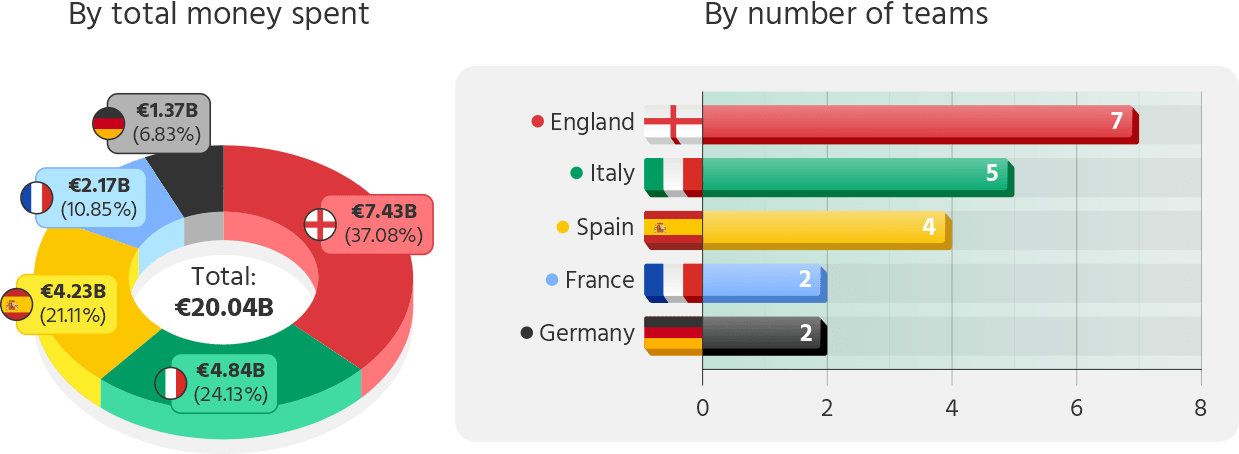

Data Source: Transfermarkt
But everything changed after 2010. Over the next decade, England stormed into the lead with force and clarity. Premier League clubs spent over €7.43 billion from 2010 to 2020 – the largest sum ever recorded in any single 10-year span. That figure dwarfed Italy’s €4.84 billion, Spain’s €4.23 billion, France’s €2.17 billion, and Germany’s €1.36 billion. The gap was no longer competitive; it was structural. What triggered this transformation? The answer is twofold. First, the Premier League’s commercial model reached maturity. Broadcasting deals, both domestic and international, exploded in value. Second, the introduction of UEFA’s Financial Fair Play regulations in 2011, intended to restrict reckless club spending, paradoxically benefited English clubs. Their enormous revenues allowed them to pass FFP benchmarks more easily, while clubs in Spain, Italy, and France were often hamstrung. The result was that while FFP was supposed to create a level playing field, it cemented England’s economic supremacy. Clubs like Manchester City and Chelsea could continue to spend freely, but within a framework that others struggled to match. In terms of representation, England surged to seven clubs in the top 20 – the same count as the previous era, but with vastly increased budgets. Spain and Italy saw similar representation, but with diminishing comparative influence. France and Germany each fielded two clubs, reflecting their growing, but still secondary, financial roles.
The 20 Football clubs in the world that spent the most money on transfers since 2020/21 season
Breakdown by Country
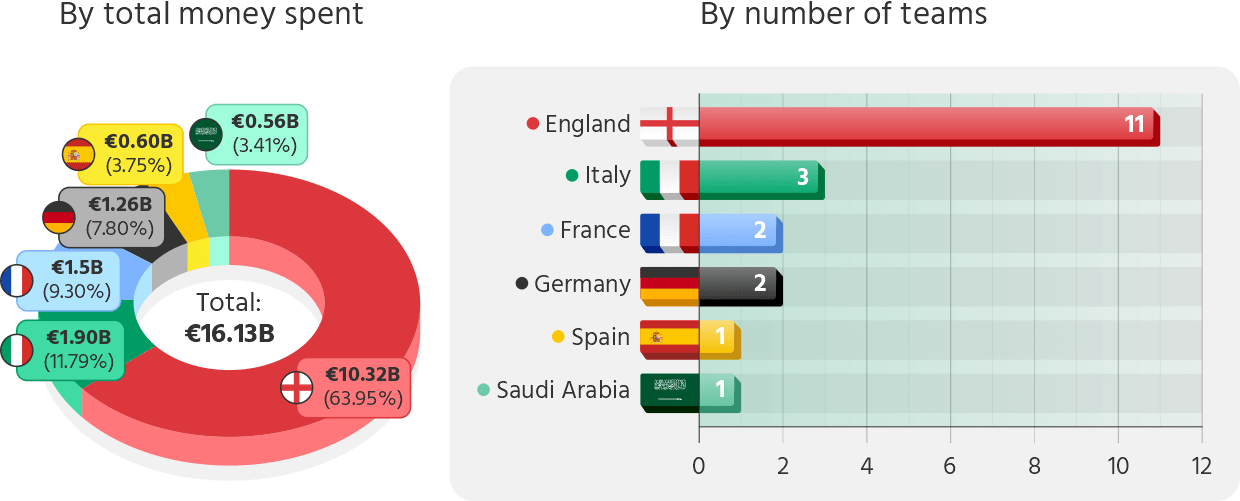

Data Source: Transfermarkt
The period since 2020 has shattered all previous benchmarks. The top 20 clubs between 2020 and 2025 spent €16.13 billion in just five years. When annualised to match the length of previous eras, the numbers become staggering. England’s 11 clubs account for more than €10.3 billion, which would extrapolate to over €41 billion over two decades – four times what Italy managed in its dominant era. Chelsea alone spent over €2 billion. Manchester City, Manchester United, Arsenal, Liverpool, Tottenham, and even mid-table sides like Aston Villa and Brighton all crossed major thresholds. The number of English clubs has never been higher – 11 of the 20 top spenders now fly the Premier League flag, up from 7 in the previous two decades and 8 in the early years. That kind of representation is unprecedented. Italy, once the gold standard, dropped to just three clubs: Juventus, Napoli, and Atalanta. France and Germany also declined to two clubs apiece. Spain is now represented only by Atletico Madrid. Real Madrid and Barcelona, once titans of the market, have dropped out of the top 20 entirely – a shocking reversal of fortunes in just 15 years. Even more telling is the emergence of Saudi Arabia. With Al Hilal spending over €550 million, the Gulf region has begun flexing its financial muscle, though still a distant shadow to England’s supremacy.
Transfer investment by the 20 highest spending teams by period (adjusted for decade)


Data Source: Transfermarkt
When adjusted for period length, the data paints a clear trajectory. From €24 million in the 1950s and ‘60s, to over €64 billion if we extrapolate the 2020s trend over two decades, the transfer market has become the ultimate financial arms race. The rise and fall of leagues and clubs is not merely a football story – it is an economic one. From Italy’s early lead to Real Madrid’s Galactico era, and now to England’s monopolistic dominance, the spending patterns of clubs reflect deeper shifts in media rights, investor appetite, fan engagement, and state involvement. The Premier League hasn’t just won the popularity contest. It has out-earned, out-legislated, and outspent every competitor in a game governed by more rules than ever — but with loopholes and leverage that only the richest can fully exploit. The only question left is whether any other nation can ever catch up. And based on current trends, that answer looks more distant than ever.
Methodology:
The spending figures for each country across the five periods were derived from Transfermarkt’s database. For every period, we identified the 20 highest-spending clubs worldwide and recorded their total transfer expenditure. Each club’s spending was attributed to its country, and national totals were calculated by summing the expenditures of all clubs from that country represented in the top 20. We chose to focus on the top 20 spending clubs in each era because this group consistently represents the elite bracket of football teams with the most financial influence.